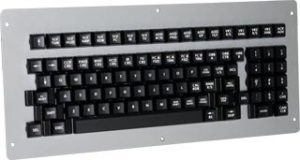Specialized, Rugged Full-Travel Keyboard
The designs for full-travel keyboard feature ergonomic layout, custom encoding with illuminated switches, legends meeting military rugged design specifications.
Features
- Low profile
- Full-travel switches
- Tactile feedback
- Illuminated legends or annunciators
- Host computer compatibility
- Custom enclosures
- Interfaces available: RS-232, 422, 433 and MIL-C-188
- Variable rollover protection
- High-speed baud rates
- Low power
The keyboard is microprocessor-based using Intel 875H-8 to scan switch closures, debounce and encode actuated key closures in correct sequence.
The switching is based upon solid state switching with switch closures reporting to the host computer via an RS-422 interface.
Optional Features
- Sculptured key caps
- Joystick
- Track ball
- Mouse I/O
Reliability is built in to operate in rugged environments. The keyboard has successfully completed testing to MIL-STD-810 and currently is flying on the E53A, C-130H and C-130U Gun Ship.
Keyboards & Keypads Technical Discussion
| RATINGS | Stated ratings of a switch are expressed in various values depending on load, voltage, contact size, material, life, etc. For example, SSM-10 is rated 10 amperes when the load is resistive in nature and the voltage is 5 V DC or 28 V DC. Exhaustive tests runs at these conditions consistently yield well over the required 25,000 cycles of life. When switching lower ampere loads, the electrical life can be expected to increase. As the switching load approaches the milliamp region, the electrical life can be expected to approach the mechanical life. When selecting a switch for your application, identify all your requirements and use the information to determine the best switch configuration needed. |
| Inductive Loads | Probably the most troublesome of circuit conditions, inductive-type loads cause premature contact erosion if not handled properly. Inductance in circuit retards current flow upon contact closure. Upon opening, current tends to keep flowing across the contact, causing arcing. Suppressors, consisting of an R-C (resistor & capacitor) for alternating current, or a diode for direct current may be recommended for severe duty. |
| Resistive Loads | Heating and other loads designated pure resistive in nature are the easiest to switch. Power factors are high and contact life is maximized because contact erosion is minimized. |
| Tungsten (lamp) Loads | Double-break switches greatly improve contact life under lamp conditions due to the interfacing action inherent in the double-break design that helps break welds. |
| CONTACTS | |
| Bounce | Total transfer time consists of the time for the contacts to close plus bounce. Transfer time, in good switch design, should be rapid so that natural bounce time is short. Switches all exhibit extremely quick closure time and therefore behave well even under tungsten loads. |
| Pressure | High contact pressure between closed contacts helps to lower the contact resistance. Heating is reduced, surface films are broken through easier, and better resistance to vibration all result from high contact pressure. Many snap-action switches feature contact pressure in the 30-pound region. |
| Resistance | Low contact resistance is important in low-level circuits. Designs consistently produce less than 25 milliohms resistance, even through the life of the switch. High contact pressure and good interfacing action are the reasons behind this excellent rating. |
| Size | Dissipating the heat from an arc is a major factor in determining the size of the contact. Heavy loads require large surfaces. |
| Materials | Size, in combination with materials and shape, help to determine contact handling ability. Gold contact plating material is the most prevalent because of its excellent conductivity and low electrical resistance. Solid gold or diffused gold contacts are used normally for low-level switching and where long shelf life is required. Rhodium and some other exotic materials are also available for special conditions. |
| Single-Break vs. Double-Break | Double-break switch designs generally will be capable of interrupting higher electrical loads over a longer life cycle. Arcing causes extremely high temperatures on the contact surface, causing pitting and contact erosion. This arcing is only extinguished by opening the gap between stationary and movable contacts to the point where the distance between these contacts is too great to sustain the arc. Single-break switches have only one contact gap. All of the energy from the arc is concentrated on the single contact, and the opening time of the contact is longer. Double-break switches break the circuit at two points simultaneously. Thus in effect, the contact gap opens twice as fast, reducing the arc duration, the contact surface temperature, and material erosion. The overall result is a longer electrical life of the contacts for heavier electrical switching requirements. |
| SWITCHES | |
| Typical Single-Pole, Single-Throw (SPST) | Switches shall be push-button, momentary SPST, normally open. The performance characteristics of the switches are as follows: |
| Bounce Time | Less than 5 milliseconds |
| Life | 1,000,000 operations minimum |
| Operating Force | 20 +/- 5 oz. |
| Max. Contact Force | 58 oz. without damage |
| Max. Current Rating | 100 ma (resistive) @ 28 V DC |
| Dielectric Resistance | 100 Megohms @ 500 V AC RMS |
| Contact Rating | 100 Millipas @ 28 V DC resistive |
| Travel to Make | 0.030 +/- 0.01 inch |

